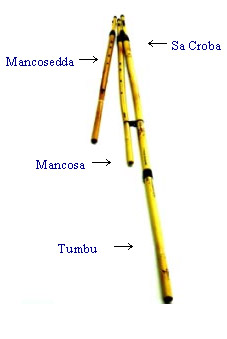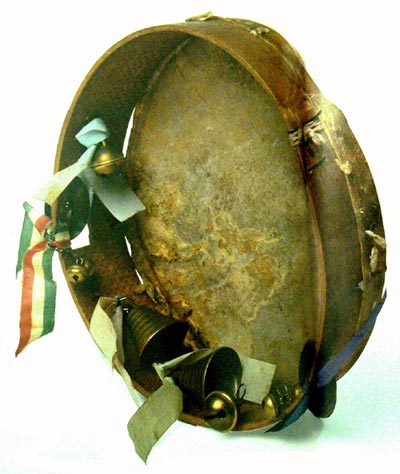The launeddas

The launeddas are the most ancient and original wind instrument of Sardinian musical tradition (in particular, they are part of the musical repertory of Cagliari’s Campidano).
They are formed by three pipes (2 tied and one loose) of common cane (Arando donax) that have different diameter, thickness and length. The “Tumbu” is the longer among them and varies from 50 to 120 cm; the “Mancosa” has four holes for the fingers, it is the intermediate cane that, tied to the Tumbu with a string, forms “Sa Croba”. Finally, the shortest of the three canes, the untied one, called “Mancosedda” or “Destrina”. It has four or five holes for the notes and it is responsible of the singable part; the others two are useful to the accompaniment.
The tuning of the beating tab is very important to guarantee the optimization of the sound. Just a good tuning allows listening to a rhythmical music and a vibrant sound.
The launeddas’ holes are rectangular while those of the others wind instruments usually are round.
The technique, used to play this instrument, is very particular and it is called “tecnica del fiato continuo” (technique of the continuous breath). The canes have to emit sounds without interruption for the whole duration of the piece, and because of that, the breath has to be given without pauses (that explains the typical inflated cheeks of the players of launeddas). The launeddas, like this generically called, take up the denomination of “cunzertu” relatively to the different length of the canes and to the different interval between the holes made in the Mancosa and in the Mancosedda.
Different types of cunzertu exist and they distinguish themselves by the different tonality. This originates sounds more or less acute, sad or merry and that seem to imitate, at least in the imagination of Sardinian countrymen, the cheerful and acute voices of children, those amorous of the girls, the sad accents of the widows or the solemn sounds of the organ.
They take their names because of a resemblance with something:
- Mediana-pipìa (girl or child)
- Fiùda (widow)
- Mongia (nun)
- Fiorassu (usually used for the Sardinian dance)
- Zampogna (bagpipe)
- Puntu de organu
- Contrappuntu
- Frasettu
- Ispinellu
- Others
We remember Adamo Billai as one of the best players of launeddas.
LISTEN: Launeddas – mediana a pipia – Orlando Mascia
The barrel organ

The first models of barrel organ appeared in Sardinia at the end of the 19th century, afterwards the manufacture of the instrument made by Paolo Soprani (1963-Castelfidardo).
The barrel organ represented an alternative to the typical local instruments (launeddas, benas, etc.) because it was made with foreign materials and technologies and not with materials of the Sardinian community. It was an object of personal purchase and use and not handed on, in accordance with community musical rules and practices.

The barrel organ spread in the island thanks to its characteristic of harmonic and tuneful instrument that agreed with the traditional music of Sardinia. Although, at first, its diffusion has favoured the centre-north part of Sardinia because of its scarce adaptability to the principles of launeddas’ polyphony (spread in Campidano), now it has the approval of the whole region.
(In the photographs we see: Soprani barrel organ, Castagnari barrel organ, Notturni barrel organ).
LISTEN: barrel organ – Giampaolo Piredda
Sulittu of the Campidano
It is an instrument of the family of the aerophones. It is a long flute with a beak, made with a single piece of common cane; its superior extremity is cut as an acute angle to form the beak. It has a knot that interrupts the body of the instrument in the middle, a rectangular window immediately under the mouth piece and four holes for the fingers (with respect to the body of the instrument, they are 3 front holes and 1 back hole).
In spite of the few holes it is possible to obtain up to 17 different sounds. It is used a lot in Cagliari’s Campidanu, where it is generically called sulittu.
Drummer
Its presence is attested in the area of Cagliari’s Campidano. It is a cylindrical drummer with double leather and it has small sizes.
It has a cylindrical case, formed by two circular wood leaves, superimposed and fixed with metal nails; the circles that stretch the leathers have circular section and are obtained from twigs of elastic wood, while the braces are Y-shaped with small bands of leather that permit to vary the tension.
The membranes are two, placed in both the parts of the drum; On the not beating membrane it is laid diametrically a taut string (called “cordiera”) with a nail, driven in the case, which serves as a real key.
The drummer was kept with a small rope fixed to the case and that was passed round the neck. The beating membrane was beaten with a small mallet that was made with hard wood and rounded in the two extremities. The drummer was usually played in pairs with the sulittu by the same player and in the previous centuries it had an important accompanying role (in dance and paraliturgical rituals).
Triangle

The triangle is formed by a metal bar (about 70 cm), folded as an equilateral triangle with an open top; it is kept hanging with a small rope and it is beaten with a metal stick. The Sardinian triangle, differently from the orchestral one that is made of steel, is made of soft iron (this iron is usually used for the reinforcement or for object of wrought iron).
The open top is characterized by an exterior curling that contributes to cause the quality of sound and pitch.
The rod that is used to beat the instrument is of iron and can have a wood handle or a simple ring-shaped bend. The triangle is an essential instrument in the ensembles of the centre Sardinia together with the sulittu, the barrel organ, the tambourine and the Jew’s harp.
LISTEN: A S’ANTIGA (sulitu – tambourine and triangle) Orlando Mascia
Accordion
Its diffusion in the island goes back to the first decades of 1900. It is a bellows instrument, spread above all to execute folk music, which in our island has partially replaced original instruments such as launeddas and sulittus. It is attested both the piano model (whit white and black keys just as that of the pianoforte) and the model with push buttons (less spread).
LISTEN: Fisarmonica – A viudedda (Ignazio Erbì)
Tambourine
Its presence is attested in the area of Cagliari’s Campidano and in the Sarrabus. It is formed by a big wood circle on whose edge it is sewn or nailed a leather membrane. The percussions on that membrane produce the sound of the instrument.
Often it is possible to find in the frame some rectangular openings where are positioned some small cymbals (formed by 2 little disks of tin) and little bells hung in cluster in the interior part of the instrument;
Both of them originate a jingling that accompanies the tambourine’s sound. In the past its size was bigger than the actual one that is reduced.



